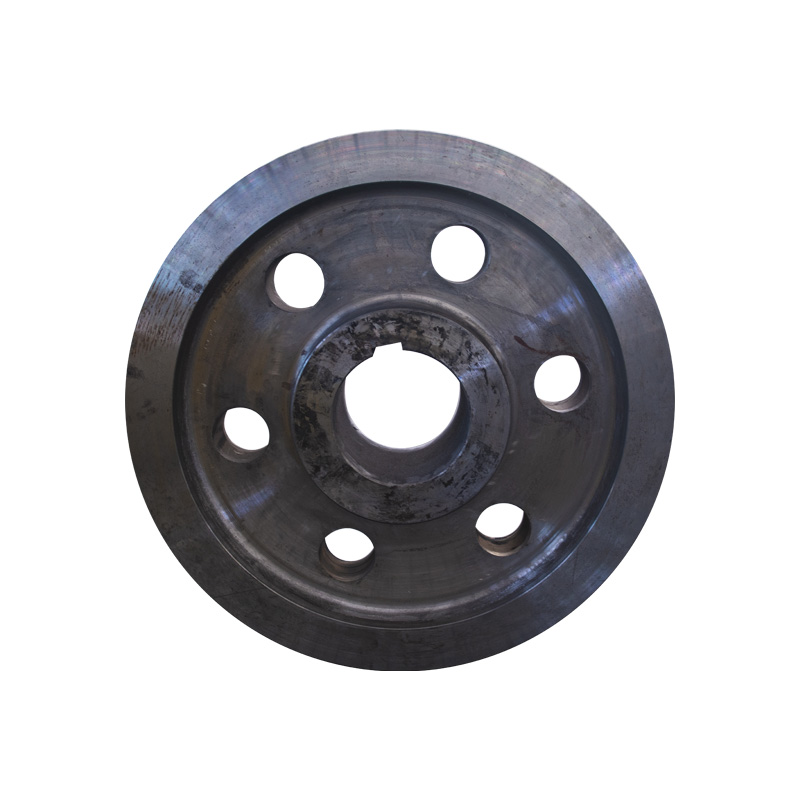Pre-forming and forming process of train wheel forging
2022-04-28
Today we are going to understand the pre-forming and forming process of train wheel forging. The forming process of train wheel forgings is the key process of rolling capacity matching of hot forming units. Reasonable and scientific forming technology not only ensures that the pressure limit value of the press can meet the technological value set in advance, but also meets the rolling capacity requirement of the rolling mill in the next process.
I. Pre-forming process of train wheel forgings
The billet of train wheel is made of cylindrical billet, and the diameter of the billet is between 380mm-406mm. High speed sawing machine is used to cut the billet into segments. After heating, a manipulator clamps the billet into a press for pre-forming process. In the preforming process, the upper grinding tool adopts the forming die, and the lower die selects the central protruding indentation die, so as to achieve the metal volume distribution of the rim and hub.
Die forging process in the press is static pressure forging, the whole forging process is completed in a stroke. Excellent pre-forming technology of train wheel can not only ensure the forming of the initial shape of train wheel, but also improve the internal structure of train wheel and metal streamline. However, if the process at this stage is not reasonable, it will directly lead to the eccentric train wheel, incomplete filling and other defects. It will bring difficulties to the operation of the subsequent processing stage, and even directly lead to the scrapping of train wheels.
Two, train wheel forging forming process
In the forming stage of train wheel forging, the shape of wheel hub and spoke plate is mainly obtained, and the forming of the main part of the rim is completed at the same time. The process is typical open die forging without flying edge. After the mold is pressed down, the first pressure is on the spoke plate of the train wheel. The inner metal of the train wheel receives the force from the central punch, driving the outer metal to flow in the horizontal direction. With the sharp increase of pressure, the outermost metal of the wheel billet contacts the inner wall of the forming die.
Under the joint action of the central punch and the inner wall of the forming die, the metal in the wheel billet forms a shunt surface, which flows to the wheel hub and the lower side of the rim and the upper side of the rim respectively. In this process, the filling condition of the lower rim is the best. In addition, due to the different height of the die bore in this process, the metal deformation in different parts of the wheel blank is different directly, among which the deformation in the spoke plate is the most prominent, while the deformation in the rim is the least.

I. Pre-forming process of train wheel forgings
The billet of train wheel is made of cylindrical billet, and the diameter of the billet is between 380mm-406mm. High speed sawing machine is used to cut the billet into segments. After heating, a manipulator clamps the billet into a press for pre-forming process. In the preforming process, the upper grinding tool adopts the forming die, and the lower die selects the central protruding indentation die, so as to achieve the metal volume distribution of the rim and hub.
Die forging process in the press is static pressure forging, the whole forging process is completed in a stroke. Excellent pre-forming technology of train wheel can not only ensure the forming of the initial shape of train wheel, but also improve the internal structure of train wheel and metal streamline. However, if the process at this stage is not reasonable, it will directly lead to the eccentric train wheel, incomplete filling and other defects. It will bring difficulties to the operation of the subsequent processing stage, and even directly lead to the scrapping of train wheels.
Two, train wheel forging forming process
In the forming stage of train wheel forging, the shape of wheel hub and spoke plate is mainly obtained, and the forming of the main part of the rim is completed at the same time. The process is typical open die forging without flying edge. After the mold is pressed down, the first pressure is on the spoke plate of the train wheel. The inner metal of the train wheel receives the force from the central punch, driving the outer metal to flow in the horizontal direction. With the sharp increase of pressure, the outermost metal of the wheel billet contacts the inner wall of the forming die.
Under the joint action of the central punch and the inner wall of the forming die, the metal in the wheel billet forms a shunt surface, which flows to the wheel hub and the lower side of the rim and the upper side of the rim respectively. In this process, the filling condition of the lower rim is the best. In addition, due to the different height of the die bore in this process, the metal deformation in different parts of the wheel blank is different directly, among which the deformation in the spoke plate is the most prominent, while the deformation in the rim is the least.

X
We use cookies to offer you a better browsing experience, analyze site traffic and personalize content. By using this site, you agree to our use of cookies.
Privacy Policy



